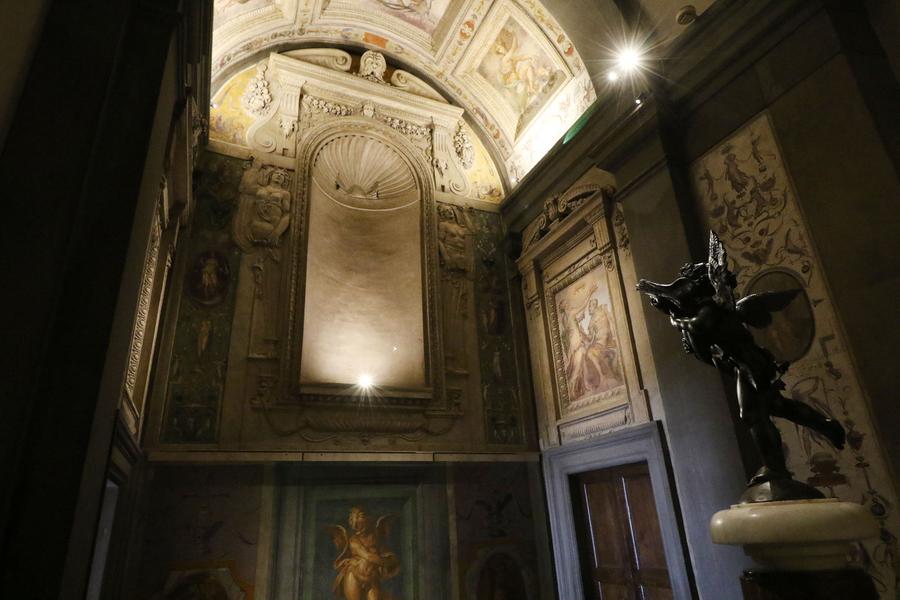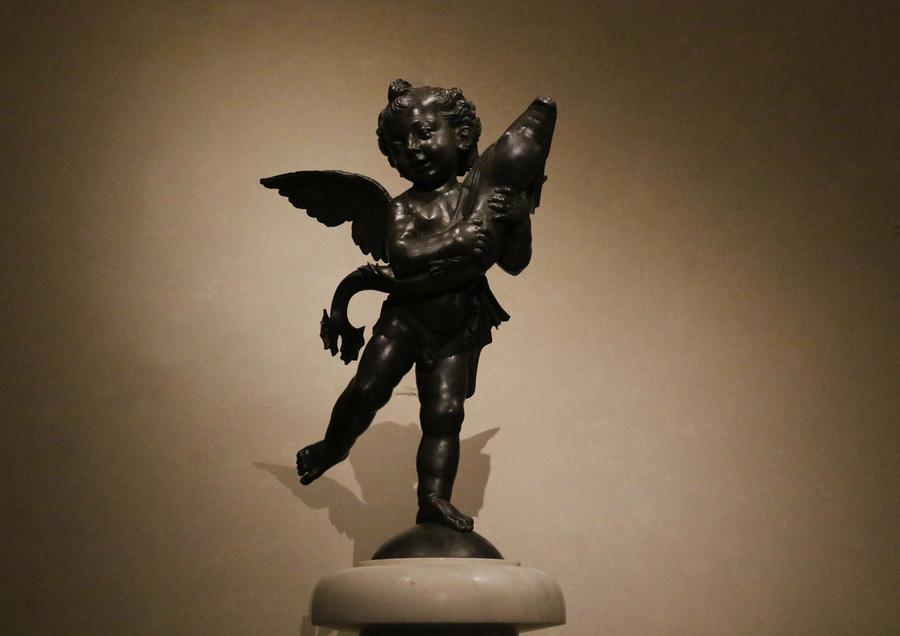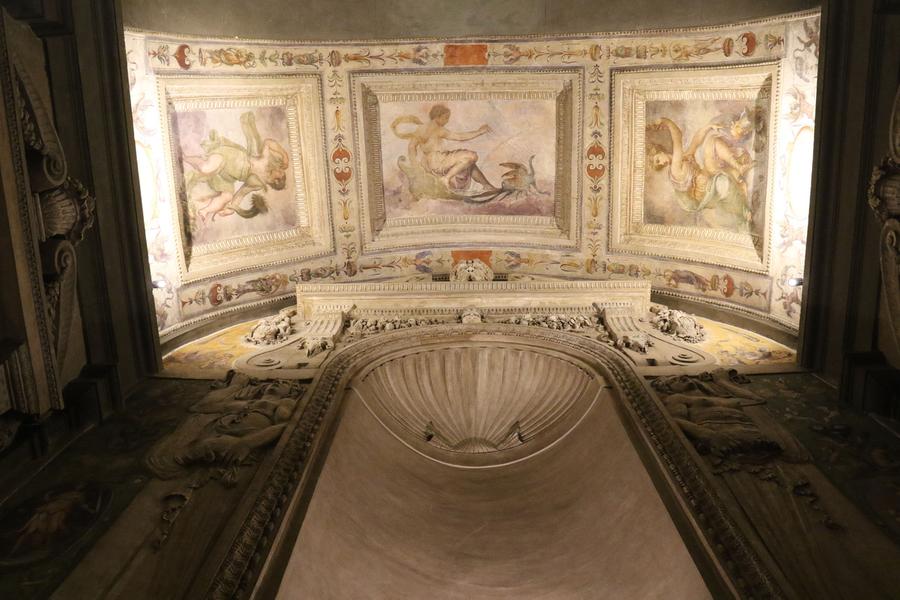Juno Terrace in Palazzo Vecchio and Verrocchio’s Putto reunited following restoration funded by Friends of Florence
- FLORENCE, Italy
- /
- March 13, 2020

Restored Juno Terrace in the Palazzo Vecchio and Verrocchio’s Putto on View Together Again
Restoration completed thanks to the generosity of the Friends of Florence
Florence, Italy…The Juno Terrace, adjacent to the Rooms of the Elements (Quartiere degli Elementi) in the Palazzo Vecchio Museum, has been restored and reunited with Andrea del Verrocchio’s Putto with a Dolphin. Both the Terrace and Putto were restored thanks to funding from the Friends of Florence Foundation. The Putto was featured in the 2019 exhibition Verrocchio: Master of Leonardo presented at Palazzo Strozzi and, titled Verrocchio: Sculptor and Painter of Renaissance Florence, at the National Gallery of Art in Washington D.C.

Following restoration costing approximately 60,000 euros, the Putto and Terrace were unveiled last week in Palazzo Vecchio during a ceremony attended by Tommaso Sacchi, municipal commissioner for cultural affairs; Simonetta Brandolini d’Adda, president of the Friends of Florence Foundation; and restorers and experts who participated in the project.
“We are proud,” said Tommaso Sacchi, “that Andrea del Verrocchio’s Putto with a Dolphin, an icon of Palazzo Vecchio ever since Cosimo I de’ Medici had it placed on the fountain in the center of the Michelozzo Courtyard, has finally returned to its original home after having been beautifully restored. We wish to thank the Friends of Florence and the Foundation’s president, Simonetta Brandolini d’Adda for their sensitivity to our cultural heritage. We are honored to have her at our side in caring for our historic monuments and artistic assets.”

“The return of Verrocchio’s Putto to its traditional home in the Juno Terrace, which has just been restored by our Foundation, completes this place of rare beauty and enormous historical and artistic distinction,” said Simonetta Brandolini d’Adda. “On behalf of the Friends of Florence, I thank Ellen and James Morton donors for the Putto; the entire board of the Foundation, Barbara and Jon Landau, and Fabrizio Moretti—the donors who made the Terrace restoration possible; the City of Florence that gave us this opportunity; the Soprintendenza that walked with us and guided us through the project; and the restorers who did the work on the enchanting Juno Terrace and Verrocchio’s exquisite Putto.”
The Juno Terrace and Putto
The Juno Terrace is one of the “new rooms” that Cosimo I de’ Medici ordered built shortly after he moved from the family residence to the building which for more than two centuries had been the seat of the city’s municipal and republican government. Located in the south-east wing of the Palazzo’s piano nobile, it is part of the Rooms of the Elements that hosted guests of the court. It was built by Battista del Tasso between 1551 and 1555, but was immediately modified by Giorgio Vasari, the painter and architect who was responsible for transforming the old Palazzo dei Priori (or della Signoria) into a lavish residence worthy of a grand duke.
Vasari and his workshop created the beautiful painted wooden panels, the stuccos, and the frescoes that embellish the rooms of the Quartiere with mythological scenes. Today, the Juno Terrace, which was completed in 1557 as an open loggia with columns facing the north-east side of Florence, is now a moderately sized room. The original designs called for a fountain in the center and a statue of the goddess Juno to one side. Although the fountain was never built, it is depicted in the center of the fresco on the lower register, where we see a mock niche with a graceful winged putto balanced on a dolphin as he pours water into round basin.
The terrace was transformed into a closed room as part of the expansion work done on the side of the building overlooking Via dei Leoni at the end of the 18th century. Since the last century, it has been home to Putto with a Dolphin by Verrocchio, one of the most important artists of the Florentine Quattrocento. Goldsmith, sculptor, and painter, he was the head of a flourishing workshop that trained masters such as Leonardo da Vinci, Pietro Perugino, Lorenzo di Credi, Sandro Botticelli and Domenico Ghirlandaio. Lorenzo the Magnificent commissioned Verrocchio to make the statue for a fountain at the family villa at Careggi, presumably in the early 1470s. It stood in the Michelozzo Courtyard until it was moved indoors (between 1957-1959) for conservation purposes and replaced with a copy by Bruno Bearzi. Its current location evokes the never-completed fountain that Vasari was to have made in the center of the Terrace. The statue is in dialogue with the similar, gilded bronze putto painted on the inside wall of the loggia.
Restoration of the Juno Terrace
The restoration project was complex and multi-faceted. The interior frescoes, for example, showed extensive overpainting, numerous attempts at reconstruction, and different types of glues and resins from previous restorations. There was blistering and loss of the paint layer, detachment of the preparatory layers, and the use of fillers was evident. To maintain the legibility of the fresco, it was necessary to preserve some reconstructions without compromising the quality and colors of the original frescoes. The surfaces required careful cleaning using a delicate procedure enabling retrieval of the original painting and, while diminishing their visual impact, saved the reconstructions of essential portions such as Juno’s head, parts of her body, and the peacocks.
The stucco decorations were covered with a thick layer of dust and a yellowish patina that also extended to the white bases of decorative elements. Some of the molded cornices had deteriorated. The careful removal of the surface patina and cleaning brought to light several reconstructions. Both the old and new fillers were camouflaged with watercolors.
When the work was completed, Verrocchio’s Putto with a Dolphin was reinstalled in the room. Finally, tempered anti-reflective glass panels were mounted to protect the frescoes and the lighting system upgraded to markedly improve the viewing experience.
Contact:
Libby Mark or Heather MeltzerBow Bridge Communications
347-460-5566
info@bow-bridge.com
















